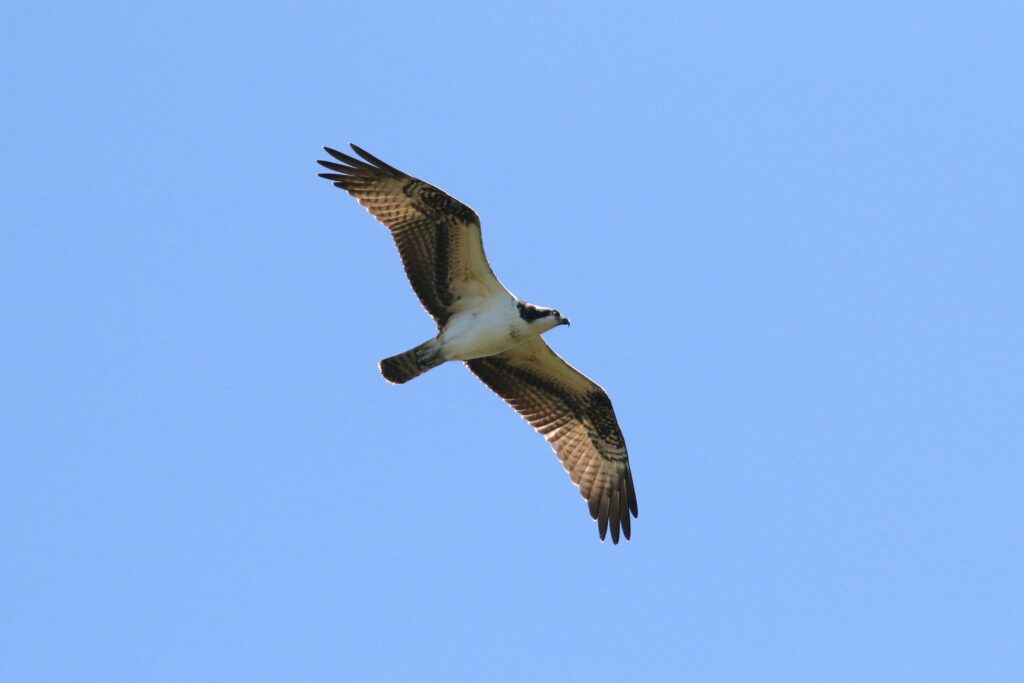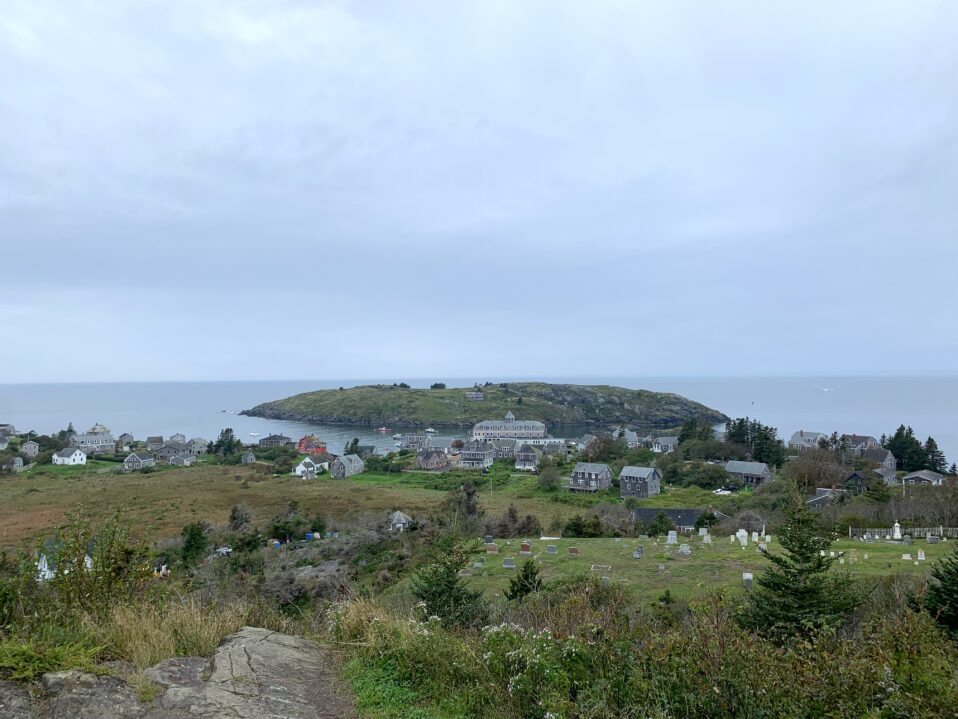Monhegan Island, Maine
September 15-20, 2023
Situated ten miles off Mid-coast Maine, Monhegan Island is a migrant trap and all-around fabulous birding location, combining birds with fantastic views and a charming and historic setting. Despite the passing of Hurricane Lee along the coast of Maine, our Monhegan Island tour was a success. Forced to stay on the mainland in quaint Boothbay Harbor for an extra day due to a cancelled ferry, we opted to scan the surging waves off Ocean Point for seabirds and stroll the woodland paths of Ocean Point Preserve. Avian sightings included Common Eiders, Black Guillemots, Common Loon, Ospreys, Bald Eagle, Merlin and Solitary Sandpipers.

Hurricane Lee’s passing at Ocean Point, Boothbay Harbor.
The hour-long ferry ride from Port Clyde provided views of the rocky coast and adjacent islands, opening up to the ocean on our way to the island. Once on Monhegan, we settled into our guesthouse/inn accommodations and four days of island birding. Birding jaunts included daily visits to the Ice Pond and notable areas along the village roads, searching the attendant lilacs, apple trees, spruces and the expanse of the Meadow. The rocky shore of the harbor provided roosting sites for gulls, while others kited on the winds over Manana, avoiding the occasional falcon passing by. Lobster Cove provided an ambiance all its own, with its mix of habitats and seaward views. Cathedral Woods and the trails through the northern portion of the island were awash with dense spruces, undulating paths and a variety of fascinating fungi. Treks to White Head and Burnt Head, headlands with cliffs of 160’ and 140’, respectively (the highest on the Atlantic Seaboard), passed through deciduous and transitional habitats, culminating in breathtaking vistas reaching all the way to Europe in our minds. With cormorants, including Great, roosting on the rocks below, Peregrine Falcons soaring overhead and Minke Whales surfacing offshore – what wasn’t to love?

Minke Whale of White Head.
Bird highlights of our days on the island were many, encompassing 91 species. A Red-necked Grebe, retaining much of its breeding plumage was a surprise in the harbor on the 17th. Several Northern Gannets were noted each day, passing the headlands and Lobster Point. As mentioned, Great Cormorants were roosting at an expected spot on the rocks below White Head, with juveniles and adult present. An immature Black-crowned Night-Heron was a flyover during a rainfall on the 18th. Along with the ever-present scattered flocks of Common Eiders, a single Green-winged Teal dropped into the Ice Pond on the 20th, 5 Black Scoters were below White Head on the 18th, and 2 White-winged Scoters passed Lobster Point on the 17th.

Northern Gannet
Raptors put on a show almost every day, with multiple Northern Harriers, Ospreys and Sharp-shinned Hawks passing overhead, Bald Eagles perched on the islets, and all three falcon species patrolled the island and Manana, most notable was the determined antics and prey-chasing of Merlins.

Osprey
Family groups of Ring-necked Pheasants, including young of varying sizes, seemed to appear almost underfoot each day. A mix of shorebirds included Lesser Yellowlegs at Fish Beach and a Wilson’s Snipe dropping into the Meadow. An adult Lesser Black-backed Gull made several appearances around the harbor, while small groups of dapper Black Guillemots bobbed in the surf at many locations around the island. A Belted Kingfisher took its rightful place on the wires over the Ice Pond, while Northern Flickers streamed by, sometimes chased by the active Merlins. Flycatchers played hard to find, but an Eastern Kingbird by the Ice Pond was very cooperative, an uncommon Western Kingbird made a brief appearance for a couple participants on the 20th, a Least Flycatcher was hiding along Tribler Rd. and a deceased Yellow-bellied Flycatcher allowed an inspection of its plumage near the Lupine Gallery.

Ring-necked Pheasant
Songbirds were very much in evidence, especially the calls of scattered Carolina Wrens. Cedar Waxwings took advantage of the Mountain Ash crop on the island each day, while Red-eyed Vireos were less numerous or conspicuous, but daily visitors. Uncommon sparrows provided a bit of excitement, with a Clay-colored Sparrow near the school on the 18th allowing for comparison with Chipping Sparrow, a Savannah Sparrow overlooking Nigh Duck on a morning jaunt, several Lincoln Sparrows subtly showing, and an adult Lark Sparrow feeding near the school on the 20th. Bobolinks called overhead daily during the morning and a few Baltimore Orioles were picked out of the colors of the fall foliage.

Lark Sparrow
Our group encountered 17 species of warblers, from bright Northern Parulas and Yellow Warblers to drab Yellow-rumped Warblers and “Western” Palm Warblers. A male Hooded Warbler and an Ovenbird played hide-and-seek along Black Head Rd. on the 19th and a Mourning Warbler did the same near the Ice Pond. Cape May Warblers presented a range of plumages, from bright adult males to inconspicuous immature females, and notably present in the “Cape May tree” – a spruce at the top of Wharf Rd. Splashes of color were also added by Magnolia Warblers, American Redstarts, Common Yellowthroats, Chestnut-sided Warbler, Black-throated Blue Warbler and Prairie Warbler. Blackpoll Warblers “zipped” overhead while Black-and-white Warblers worked their way through the trees below. Despite searching, rare occurrences of a Yellow-throated Warbler and MacGillivray’s Warbler (2nd island record) eluded the group. Rose-breasted Grosbeaks, Indigo Bunting and an uncommon Dickcissel rounded out the island sightings.

Dickcissel
There were non-avian highlights as well, with up to three Minke Whales surfacing repeatedly off White Head on the 18th. Butterflies and dragonflies added splashes of color wherever we went, with numerous Monarchs taking advantage of the host of blooming flowers. Harbor Porpoises, Harbor Seals and Gray Seals made appearances from the return ferry, finishing off a wonderful trip.

Gray Seal of Black Head.











